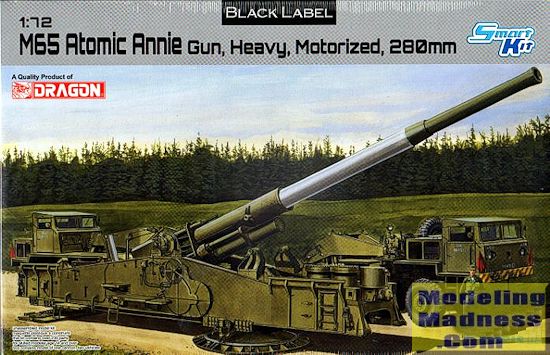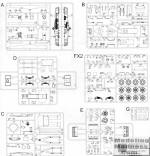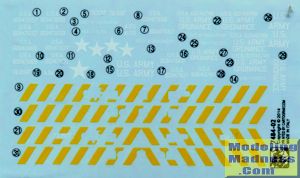
| KIT #: | 7484 |
| PRICE: | $88.00 SRP |
| DECALS: | Three options |
| REVIEWER: | Scott Van Aken |
| NOTES: | Short run with photo etch and resin parts |

| HISTORY |
The M65 Atomic Cannon, often called Atomic Annie, was a towed artillery piece built by the United States and capable of firing a nuclear device. It was developed in the early 1950s, at the beginning of the Cold War, and fielded by 1953 in Europe and Korea.
Picatinny Arsenal was tasked to create a nuclear capable artillery piece in 1949. Robert Schwartz, the engineer who created the preliminary designs, essentially scaled up the 240mm shell (then the maximum in the arsenal) and used the German K5 railroad gun as a point of departure for the carriage. (The name "Atomic Annie" likely derives from the nickname "Anzio Annie" given to a German K5 gun which was employed against the American landings in Italy.) The design was approved by the Pentagon, largely through the intervention of chief of the Ballistics Section of the Ordnance Departmentís Research and Development Division, Samuel Feltman, and a three-year developmental effort was begun. The project proceeded quickly enough to produce a demonstration model to participate in Dwight Eisenhower's inaugural parade in January of 1953.
The cannon was transported by two specially designed tractors, both capable of independent steering in the manner of some extra-long fire engines. Each of the tractors was rated at 375 hp, and the somewhat awkward combination could achieve speeds of 35 miles an hour and negotiate right turns on 28 ft wide, paved or packed roads. The artillery piece could be unlimbered in 15 minutes and then returned to traveling configuration in 15 minutes more.
On May 25, 1953 at 8:30am local time, the Atomic Cannon was tested at Nevada Test Site (specifically Frenchman Flat) as part of the Upshot-Knothole series of nuclear tests. The test--codenamed Grable--was attended by then Chairman of the Joint Chiefs of Staff Adm. Arthur W. Radford and Secretary of Defense Charles E. Wilson; it resulted in the successful detonation of a 15 kt shell (warhead W9) at a range of 7 miles. This was the first and only nuclear shell to be fired from a cannon.
Subsequent to the successful test, there were at least 20 of the cannons manufactured at Watervliet and Watertown Arsenals, at a cost of $800,000 each. They were deployed overseas to Europe and Korea, often continuously shifted around to avoid being detected and targeted by opposing forces. Due to the size of the apparatus, their limited range, the development of nuclear shells compatible with existing artillery pieces (the W48 for the 155mm and the W33 for the 203mm), and the development of rocket and missile based nuclear artillery, the M65 was effectively obsolete soon after it was deployed. However, it remained a prestige weapon and was not retired until 1963.
Of the 20 built, 8 are on display in various parts of the US.
| THE KIT |
 Dragon's Black Label line is usually for limited production military vehicles and I would guess that this one falls into that category. It is all new tool and unless there is a future need for M249 tractors, you probably will not see any of this kit used elsewhere. There are two tractors which have many of the same parts, but not the same layout. The aft tractor has the driver facing towards the canon, otherwise the construction of both are about the same. There is an interior with each one that consists of seats, control wheels and foot pedals. Each has a full suspension along with fuel tanks, transfer cases, drive shafts and the rest of what you'd expect on the underside of these. All of the tire/wheel assemblies are in two halves. All of the clear bits are for the tractor windows.
Dragon's Black Label line is usually for limited production military vehicles and I would guess that this one falls into that category. It is all new tool and unless there is a future need for M249 tractors, you probably will not see any of this kit used elsewhere. There are two tractors which have many of the same parts, but not the same layout. The aft tractor has the driver facing towards the canon, otherwise the construction of both are about the same. There is an interior with each one that consists of seats, control wheels and foot pedals. Each has a full suspension along with fuel tanks, transfer cases, drive shafts and the rest of what you'd expect on the underside of these. All of the tire/wheel assemblies are in two halves. All of the clear bits are for the tractor windows. The gun barrel is three parts with the first half of the barrel a single mold and the portion nearest the mount in halves. A lot of the mechanism on the gun itself is put into the elevation equipment, which is huge. There is also a nicely done breech area. Naturally, the elevation pistons are designed to slide so you can elevate the gun. While the drawings in the instructions show the gun elevated while attached to the tractors, I doubt if that was actually the case, though I don't know for sure. There are markings provided for three vehicles, all in overall olive drab. Two were from units based in Germany. One is the 59th Field Artillery Battalion in 1954 and the other with the 216th Field Artillery Battalion in 1955. The other is one held at the Aberdeen Proving Grounds during the 1950s. The decal sheet is nicely done and offers basically serials and stencils.
The gun barrel is three parts with the first half of the barrel a single mold and the portion nearest the mount in halves. A lot of the mechanism on the gun itself is put into the elevation equipment, which is huge. There is also a nicely done breech area. Naturally, the elevation pistons are designed to slide so you can elevate the gun. While the drawings in the instructions show the gun elevated while attached to the tractors, I doubt if that was actually the case, though I don't know for sure. There are markings provided for three vehicles, all in overall olive drab. Two were from units based in Germany. One is the 59th Field Artillery Battalion in 1954 and the other with the 216th Field Artillery Battalion in 1955. The other is one held at the Aberdeen Proving Grounds during the 1950s. The decal sheet is nicely done and offers basically serials and stencils. | CONCLUSIONS |
Because of the nature of the kit it is not inexpensive. However, it offers several benefits over the larger and less expensive Renwal kit released a few years back. One is that this one is more likely to fit on your display shelves. The other is that it is modern tooling and has as much if not more detail than the kit from the 50's/60's. If artillery is your forte and you don't mind working in 1/72 for big guns like this, it is well worth picking up.
| REFERENCES |
http://en.wikipedia.org/wiki/Atomic_cannon
March 2015
Thanks to www.dragonmodelsusa.com for the preview kit. You can get this one at your local retailer.
If you would like your product reviewed fairly and quickly, please contact the editor or see other details in the